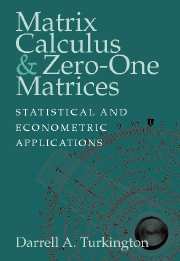6 - Seemingly Unrelated Regression Equations Models
Published online by Cambridge University Press: 14 September 2009
Summary
INTRODUCTION
On a scale of statistical complexity, the seemingly unrelated regression equations (SURE) model is one step up from the linear-regression model. The essential feature that distinguishes the two models is that in the former model the disturbances are contemporaneously correlated whereas in the latter model the disturbances are assumed independent.
In this chapter, we apply classical statistical procedures to three variations of the SURE model: First we look at the standard model; then, as we did with the linear-regression model, we look at two versions of the model in which the disturbances are subject to vector autoregressive processes and vector movingaverage processes. In our analysis, we shall find that our work on generalized vecs and devecs covered in Sections 2.4 and 4.7 particularly relevant. The duplication matrix discussed in Section 3.5 will make an appearance as will elimination matrices (Section 3.4).
From the practice established in the previous chapter, the asymptotic analysis needed in the evaluation of information matrices is given in Appendix 6.A at the end of the chapter, in which appropriate assumptions are made about the existence of certain probability limits. We can obtain the matrix calculus rules used in the differentiation of this chapter by referring to the tables at the end of Chap. 4.
- Type
- Chapter
- Information
- Matrix Calculus and Zero-One MatricesStatistical and Econometric Applications, pp. 110 - 145Publisher: Cambridge University PressPrint publication year: 2001



